The star-spangled curtain of black has a circular window glowing cold white. Dew is busy condensing to frost. We’re so busy talking we fail to take the Taihape turn off and realise only when the sign for Wanganui is silhouetted by our headlights. With renewed focus we feel our way north spurning the main road to Waioru in favour of darkness. My soda water bottle lying on the floor of the car acts as a spirit level rolling left and right as we wind our way between hills. Detaching from the hill cover where the Pukeokahu and Mangahoata roads meet Grethe steers us left towards the Pukeokahu school and our campsite. A home-made sign directs us to a paddock where a cluster of shadowy tents stand to attention flanked neatly by cars. Viktor, our welcoming party of one, indicates the precise location of our respective tents. With the car engine extinguished the only sounds are Moreporks and the occasional bark of a dog.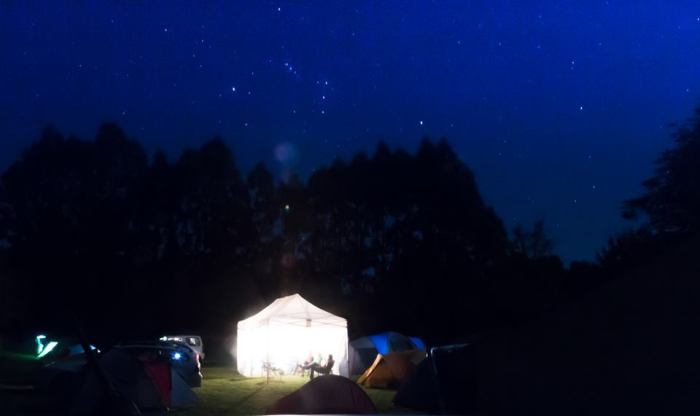
Camp light. Photo by Jan Ducnuigeen
The camp stutters to life early. Runners in pajamas and gumboots trot a sleepy path between portoloos, showers and communal kitchen tent comparing notes on the chilly night while making coffee and spooning down muesli. My tent is alpine so I don’t realise what the fuss is about until I climb out. My Olympus is wrapped in an ice throw. The tide lines of clippings on the freshly mown lawn are white moustaches. The air is crisp but the sky’s cloudless foundation promises warmth to come. The sun is on the rise but it will be an hour or so before it blushes the campsite. I snuggle further into my down jacket.
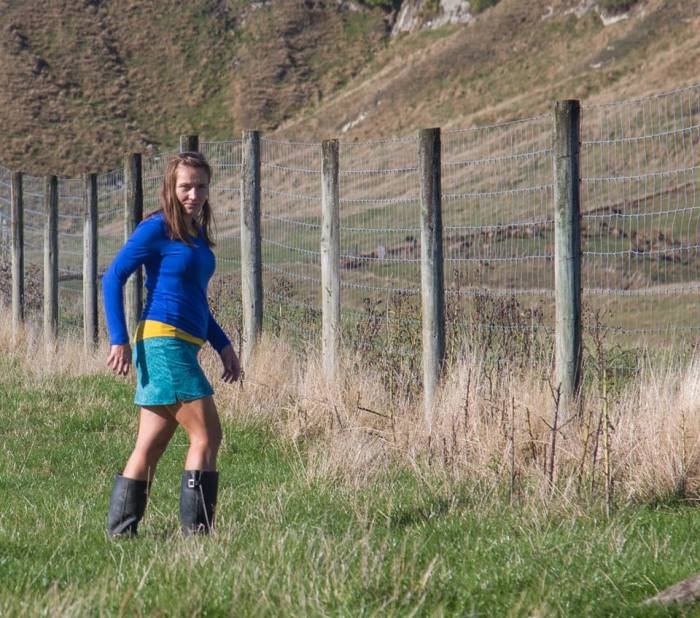
Camping style. Photo by Jan Ducnuigeen
I’ve listened to friends talk about the race for months. The concept intrigues me. The location is unfamiliar, somewhere I can’t pronounce, have never heard of let alone visited. The course sounds tough so does the socialising. In order to conserve energy for post race activities many returning runners have decided to form relay teams this year rather than run the entire marathon. A couple of days before the event Viktor, coming back from an injury and planning to go up anyway, is persuaded to enter a team. Carys and I agree to join.
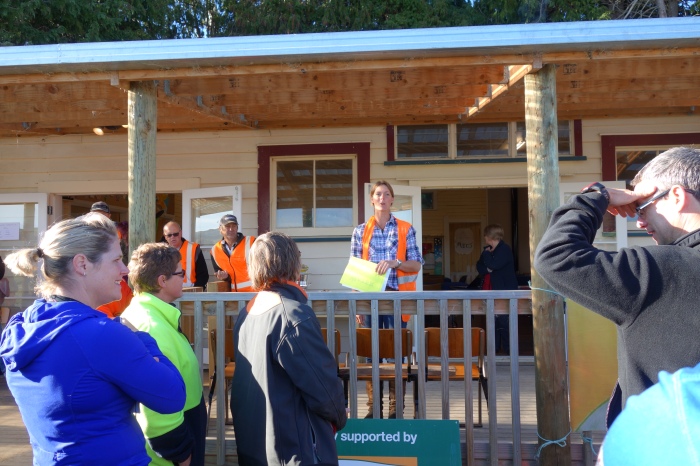 Race briefing.
Race briefing.
It’s too late to train. I check the website which is light on detail but well stocked with rules and advice. My favourites: ” Follow the 6 Ps: Prior Preparation Prevents Particularly Poor Performance” and no tailing (holding onto a tail). The rules seem weighted towards human runners with our competition subject to veterinary checks pre, mid and post race, banned from cantering or galloping on metal or sealed roads and not permitted to jump gates. To add to their compliance costs those that kick have to wear a red ribbon on their tails and those of a nervous disposition a green one. Then there is the course itself, not many details about that on the website either but the area around Taihape is rolling hill country and a glance at a map identifies Pukeokahu hill (938m). I’m picking a bit of elevation along with carrying a human rider will further tip the playing field in favour of my species.
Horses in action photos by Jan Ducnuigeen.
But even with a rule book advantage can a human beat a horse? The idea seems implausible – horses have four legs, humans two. The key is endurance. Horses are undoubtably quick over short distances but humans are ideally built in biomechanical terms, for running long distances. We’ve evolved with superior inner ear balance, springier tendons, narrow waists and relatively large backsides. We are capable of great agility on turns and rough terrain and we can cool ourselves more efficiently in the heat. We don’t have to stop to pant, and we have sweat glands. So long as we’re adequately fed and watered we should be capable of running further and faster than a horse.
Race start. Photos by Brent O’Connor
Humans have a longer stride than horses allowing us to cover distance more efficiently. Horses only appear to possess long strides, in reality their hooves swing back before touching the ground. Researchers discovered this by accident. Attempting to videotape a horse running to see how its breathing coordinated with its gait one researcher ran beside the horse to stop the equipment getting tangled. Replays of the videotape showed that although the horse and the man were moving at the same speed the mans legs were moving more slowly. Turns out humans cover more distance per step.
The theory has been tested in places like Arizona in the US and in Wales. Humans have sporadically beaten horses in marathon distance races. Check out this clip from the annual race in Wales.
New Zealand is a good place to stage a human versus horse race – plenty of open space, plenty of horses, enough humans prepared to compete. The small community of Pukeokahu just north of Taihape has a tiny primary school that caters for 13 pupils. Fundraising for such a school is tough but Lizzie Maunsell came up with the enterprising fundraising solution of staging the only Human v Horse race in the Southern Hemisphere. When my local running group heard about the race we were immediately attracted to the project. Here was someone offering an opportunity to test for ourselves the theory made popular by Chris McDougall in his bestseller “Born to Run”. Plus we recognised in the Pukeokahu community something of ourselves.
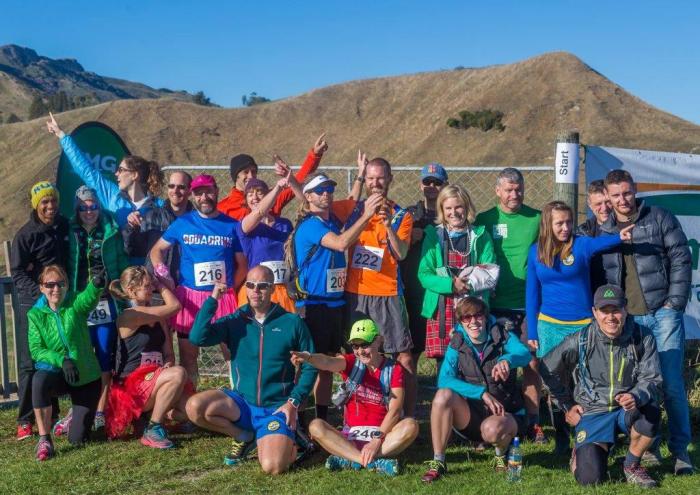 Posse of Welly runners, photo by Jan Ducnuigeen.
Posse of Welly runners, photo by Jan Ducnuigeen.
Down at the community hall where Lizzie will give her race briefing I get my first chance to meet the locals. The race doesn’t start till 9.30am, there is no traffic to negotiate and both horses and humans have camped nearby so there is space for talking to the other runners, horse riders and supporters. There is an eclectic mix of participants both experienced and novice. A couple from Tasmania are back hoping to improve on last year’s performance. A smiling local is aiming for his first marathon. A few road runners from the neighbouring harriers club will be testing their speed on trails.
From Welly there is a relay team named “Can’t Walk Anymore” (everyone has to have a team name, it’s in the rules). If Grethe, Michael and George complete the race they will all have run further than they’ve ever run before. When I learn Michael has done two runs so far this year I quiz him on race strategy. “I think of it as overcoming distance” he tells me.
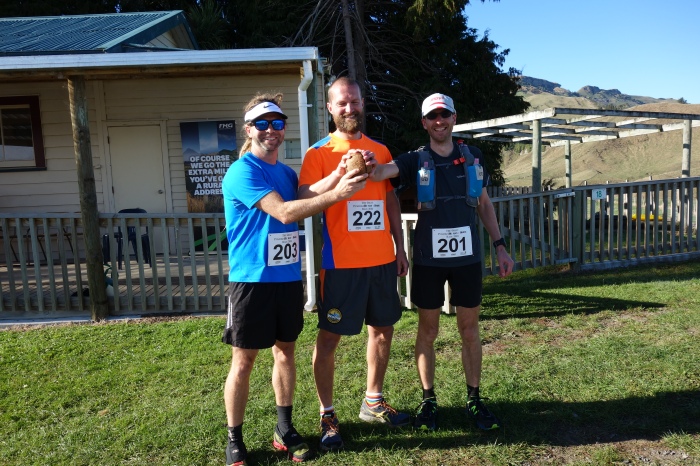
Individual marathon runners from Welly and a few of the relay teams, “The Greybeards”, “The Prancerciers”, “We knew it was Hel(l) from the Start” and “Can’t Walk Anymore”.
There is a big crew of locals busy in the race engine room, the kitchen. These non running teams have their sleeves rolled up and are getting about the business of preparing food to top the glorious Friday evening meal that Grethe and I missed. Hot drinks are prepared, home baking offered round, dishes are being washed on a continuous cycle as everyone catches up on the gossip. I’m reminded of my own rural upbringing.
My nostalgic moment is shattered when Lizzie calls us to attention for the race briefing. With her parting words “may the best beast win” ringing in our ears we move off. The humans start first to avoid getting trampled, the horses 15 minutes later. It quickly becomes apparent that I’ve scored the most scenic leg and that the course is meticulously prepared. We follow the neat little red arrows on white paper and pink fluorescent markings up Pukeokahu hill. As we climb and look out across the plateau the familiar shape of Mt Ruapehu emerges on the skyline. I can’t resist pausing frequently to take photos.There is an official photographer at the first water station and lots of friendly marshals cruising the course on quad bikes.
First leg of the race.
The trail winds its way up the hill then undulates on a combination of farm tracks and open paddocks. The terrain is uneven, lumpy and hard to read – prime ankle turning territory. Despite their home advantage the horses are finding it tricky too as there are numerous closed gates to negotiate. I don’t witness it myself but other runners from the later legs which involve more gates describe the gate strategy perfected by horses and riders. Rider leans in and unlatch the gate then give the horse a nudge so it pushes the gate open and moves through – no need to dismount. A rider explains that the horses go faster if they can see someone to chase, without a horse or a human in view they quickly lose motivation so a key part of their race strategy is to stay with the pack.
Relay change-over, photos by Jan Ducnuigeen.
I don’t want my part of the run to end but I can delay no longer and hand my coloured rubber bracelet to Carys who bounds off intent on making up the time I’ve squandered. I head back up the hill to cheer a few of the competitors still coming through then we all walk to the start/finish line for a few cups of tea and toasted sandwiches while we wait for the rest of the participants to reappear.
Best beasts, photos by Sharron and Jan Ducnuigeen.
Conditions this year are better than the previous and first year of the race. In 2015 the competitors ran in the rain and the course was muddy. This year the course is dry and conditions are warm. We’re not sure how the change will impact on the battle of the beasts. The locals think conditions will favour both parties. It transpires they are correct. The first competitor home is a horse, Matahiwi Phoennix ridden by Maureen. Their time is just over three and a half hours, a race record. Stu is not far behind completing the course in a few seconds over 4 hours. Less of a gap between human and horse this year and Stu has outrun all except one horse.
While the best beasts busy themselves with recovery the rest of the field start to trickle in. We get word that a runner has sustained an injury but is carrying on. Later Brent hobbles in with a badly bruised foot. He trod on a rock hidden in the long grass at the start of the second leg. Elspeth rolled her ankle on the first leg. Lucky for humans we don’t have to pass vet checks, 4 of the 9 horses are vetted out of the race.
Post race camaraderie, photos by Sharron and Jan.
A pleasant afternoon of sunshine fuelled camaraderie stretches into the evening interrupted briefly by the prize giving. Local sponsors have been generous and there are lots of spot prizes as well as prizes for the winners. I score a huge chunk of beef which Viktor, Michael and George will later transform into goulash. Prize giving is followed by a big feed of venison complimented by a vast array of interesting salads proving that the kitchen talent is at least a match for the athletic talent. It dawns on me that it was the food rather than beating the traffic, that motivated everyone to take Friday afternoon off work.
Piles of people, piles of plates, piles of bottles sprawl across trestle tables and spill out on the verandah that serves as the hub between indoors and another clear, star sprinkled night. Race tales grow taller by the hour. Runners are plotting their come back, horse people are comparing notes on performance too. Later a local band plays in the hall although my social endurance is pathetic so I’ve already retreated to the solitude of my tent to listen to the Moorporks and dogs and dream of my next adventure.
Prize giving watched over by pupils at Pukeokahu Primary and post race feed.

























